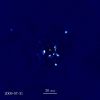-
 +4 +1
+4 +1How would we know whether there is life on Earth? This bold experiment found out
Thirty years ago, astronomer Carl Sagan convinced NASA to turn a passing space probe’s instruments on Earth to look for life — with results that still reverberate today.
-
 +16 +1
+16 +1We Live in the Rarest Type of Planetary System
A planetary system is shaped at the boundary of order and chaos. It starts out as a molecular cloud—a big, cold clump of mostly hydrogen gas that can collapse to make stars. As central stars form, the remainder of the cloud flattens into a whirling protoplanetary disk that weaves together worlds from turbulent swirls of gas, ice and dust. From there larger-scale chaos can ensue as bigger planets push smaller ones around.
-
 +26 +1
+26 +1It's not just climate – we've already breached most of the Earth's limits. A safer, fairer future means treading lightly
People once believed the planet could always accommodate us. That the resilience of the Earth system meant nature would always provide. But we now know this is not necessarily the case. As big as the world is, our impact is bigger.
-
 +13 +1
+13 +1Earth has been pushed past its safe limits for humans, scientists say
Humans have sent almost all planetary boundaries into risk zones, research finds
-
 +25 +1
+25 +1This Volcano-Covered Planet May Be Habitable to Alien Life
At first glance, LP 791-18 d seems like a lively place. If new findings from NASA researchers hold up, the Earth-sized exoplanet orbiting a star 90 light-years away from us is teeming with active volcanoes all over its surface. Interesting, sure—but clearly no place for life to thrive, right?
-
 +4 +1
+4 +1There are More Than 85,000 Volcanoes on Venus
Researchers have mapped more than 85,000 volcanoes on the surface of Venus — but suspect there may even be more.
-
 +24 +1
+24 +1James Webb telescope detects water vapor in nearby star system, but its origin remains a mystery
The James Webb Space Telescope may have just given the world another monumental scientific breakthrough. On Monday, NASA announced that astronomers detected water vapor around a distant rocky planet with the help of JWST.
-
 +25 +1
+25 +1First up-close images of Mars’s little-known Moon Deimos
The United Arab Emirates’ space probe Hope has taken the first high-resolution images of the farside of Mars’s moonlet Deimos. The observations add weight to the theory that Deimos formed together with Mars, rather than as an asteroid that was captured in the planet’s orbit, mission scientists say.
-
 +19 +1
+19 +1Astronomers are using AI to discover fledgling planets
The number of known exoplanets has veritably exploded in recent years, with more than 5,000 worlds beyond our solar system now known. But there’s a catch: The worlds we’ve found are typically those easiest to detect. It’s only as techniques and technology improve that astronomers are able to discover planets that are harder to see.
-
 +23 +1
+23 +1For the first time, scientists detect seismic waves rattling through Mars' core
The observations reveal how the interior of the Red Planet works
-
 +11 +1
+11 +1Artificial intelligence to aid future exoplanet hunt
A new challenge invites Artificial Intelligence (AI) and machine learning experts to join astronomers in the quest to discover and understand planets outside the solar system, also known as extrasolar planets or "exoplanets."
-
 +20 +1
+20 +1Chemical reactions on the early Earth may have formed its ocean
Conditions that favor water may be common in the formation of rocky planets.
-
 +23 +1
+23 +1Webb telescope finds a 'hot Jupiter' exoplanet that defies expectations
The atmospheres of gas giant planets across the Milky Way galaxy can be very different from those in our solar system, the James Webb Space Telescope has found. Observations of the distant exoplanet HD149026b, also known as Smertrios, revealed that the planet's atmosphere is rich in what scientists call heavy elements, essentially anything other than hydrogen and helium. In Smertrios' atmosphere, the James Webb Space Telescope detected high concentrations of carbon and oxygen.
-
 +22 +1
+22 +1It's a bird! It's a plane! It's a pretty neat planetary viewing!
This week, you have an opportunity to acquaint yourself with some of our solar system neighbors and reduce some of your screen time.
-
 +22 +1
+22 +1When, where, and how to see the rare alignment of 5 planets in the night sky this month
Don't miss the planet parade taking place at the end of March. Jupiter, Mercury, Venus, Uranus, and Mars are set to align in an arc formation on the nights of March 25 through 30, alongside the moon. Jupiter may sink into the sunset and get lost in sunlight after the 28th, though, so aim to see this relatively rare cosmic event by then. If you want to spot all five planets in one night, timing, dark skies, and a clear view of the horizon are key.
-
 +19 +1
+19 +15 planets will align in a 'planetary parade' next week. Here's how and when to see it.
Though we all have differences, there’s one commonality that has prevailed for all of humanity: we are all floating on a rock, flying through outer space at over a million miles an hour. Thanks to the rapid advancement of technology in the past century, we can observe more of the Universe than ever before.
-
 +16 +1
+16 +1James Webb Space Telescope spies hot, gritty clouds in skies of huge exoplanet with 2 suns
NASA's prolific James Webb Space Telescope (JWST) has made yet another stunning discovery. The pioneering observatory just peered directly into the atmosphere of a giant exoplanet with two suns (like Tatooine from "Star Wars") known as VHS 1256 b(opens in new tab) — and found a roiling world with turbulent clouds made of silicates, similar to sand here on Earth, as announced in a recently published article in Astrophysical Journal Letters
-
 +3 +1
+3 +1What Would Happen if the Solar System Gained a Super-Earth?
Our Solar System is odd because it has no Super-Earth. But what would happen if it did? Simulations show that we're better off without one.
-
 +16 +1
+16 +1A planned Uranus probe wouldn't get there till the 2040s. Here's why
Neptune and Uranus have long been neglected when it comes to solar system exploration. Many astronomers think that is a shame, as these two planets are particularly weird outliers among the bodies that orbit the Sun. Uranus, for example, the seventh planet from our Sun, has a unique tilt that makes it appear to spin sideways, orbiting the Sun like a rolling ball while circled by nine, dense rings. Both Uranus and Neptune may also have diamond rain in their atmospheres.
-
 +13 +1
+13 +1NASA’s Curiosity Rover Finds ‘Never Seen Evidence’ Of Water On Mars
This discovery offers new insights into the water history of Mars and the possibility of ancient life on the Red Planet.
Submit a link
Start a discussion




















